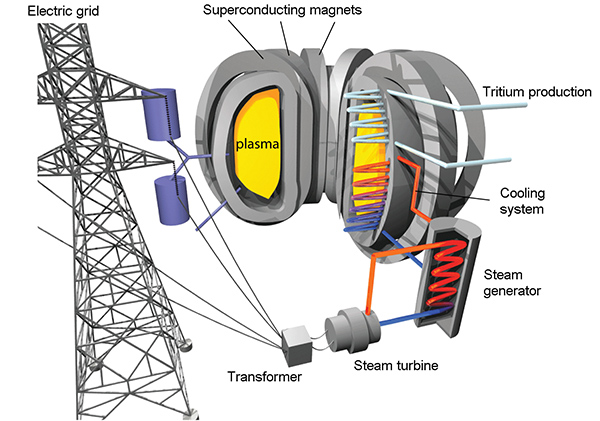fusion energy
EXPLAINING THE FORMATION OF THE RAW MATERIAL
But fusion reactors have other serious problems that also afflict today's fission reactors, including neutron radiation damage and radioactive waste, potential tritium release, the burden on coolant resources, outsize operating costs, and increased risks of nuclear weapons proliferation.
EXPLAIN HOW THE PLANT WORKS
In a fusion reaction, energy is released when two light atomic nuclei are fused together to form one heavier atom. This is the process that provides the energy powering the Sun and other stars, where hydrogen nuclei are combined to form helium. BENEFITS OF THECNOLOGYS ASSOCIATED WITH FUSION
BENEFITS OF THECNOLOGYS ASSOCIATED WITH FUSION
The following advantages make fusion worth pursuing. Abundant energy: Fusing atoms together in a controlled way releases nearly four million times more energy than a chemical reaction such as the burning of coal, oil or gas and four times as much as nuclear fission reactions (at equal mass). RISK OF FUSION ENERGY
RISK OF FUSION ENERGY
But fusion reactors have other serious problems that also afflict today's fission reactors, including neutron radiation damage and radioactive waste, potential tritium release, the burden on coolant resources, outsize operating costs, and increased risks of nuclear weapons proliferation.
But fusion reactors have other serious problems that also afflict today's fission reactors, including neutron radiation damage and radioactive waste, potential tritium release, the burden on coolant resources, outsize operating costs, and increased risks of nuclear weapons proliferation.

EXPLAIN HOW THE PLANT WORKS
In a fusion reaction, energy is released when two light atomic nuclei are fused together to form one heavier atom. This is the process that provides the energy powering the Sun and other stars, where hydrogen nuclei are combined to form helium.
 BENEFITS OF THECNOLOGYS ASSOCIATED WITH FUSION
BENEFITS OF THECNOLOGYS ASSOCIATED WITH FUSIONThe following advantages make fusion worth pursuing. Abundant energy: Fusing atoms together in a controlled way releases nearly four million times more energy than a chemical reaction such as the burning of coal, oil or gas and four times as much as nuclear fission reactions (at equal mass).
 RISK OF FUSION ENERGY
RISK OF FUSION ENERGYBut fusion reactors have other serious problems that also afflict today's fission reactors, including neutron radiation damage and radioactive waste, potential tritium release, the burden on coolant resources, outsize operating costs, and increased risks of nuclear weapons proliferation.
Comments
Post a Comment